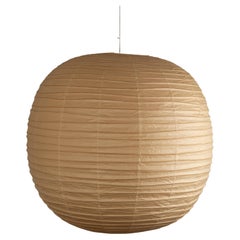Akari 125f
Recent Sales
Vintage 1950s Japanese Chandeliers and Pendants
Metal
Vintage 1950s Japanese Mid-Century Modern Chandeliers and Pendants
Metal
Isamu Noguchi for sale on 1stDibs
A sculptor, painter, ceramicist and furniture and lighting designer, Isamu Noguchi was one of the most prolific and protean creative forces of the 20th century and a key figure in the development of organic modernism. Noguchi’s sculptures and designs — his chairs and tables as well as his timeless Akari lamp and other lighting fixtures — share a common spirit: one of lyrical abstraction, tempo and flow and harmonious balance.
Noguchi was born in Los Angeles to an American mother and Japanese father, and spent most of his childhood in Japan. He returned to the United States at age 13, went to high school in Indiana and enrolled at Columbia University to study medicine. At the same time, he took night courses in sculpture.
Within three months, Noguchi left college to pursue art full time. Noguchi was awarded a Guggenheim Fellowship in 1927 and traveled to Paris to work under Constantin Brancusi. It marked a turning point. Inspired by Brancusi, Noguchi embraced abstraction and began to sculpt in the expressive, rhythmic style that would be the hallmark of his work.
Once back in New York, Noguchi was introduced to design by what would become a lifelong collaboration creating sets for choreographer Martha Graham. His first industrial designs were in Bakelite: the sleek Measured Time kitchen timer created circa 1932, and his famed Zenith Radio Nurse intercom, from 1937.
Ten years later, Herman Miller introduced Noguchi’s now-iconic glass-topped coffee table with an articulated wooden base. His washi paper and bamboo Akari light sculptures, handmade in Japan, debuted in 1951. In the late 1950s, Noguchi designed for Knoll, creating such pieces as his dynamic Cyclone table and rocking stool.
For collectors, Noguchi’s furniture and lighting designs remain his most accessible work — they have the same power and presence that Noguchi brought to his art.
Find vintage Isamu Noguchi floor lamps, table lamps, coffee tables and other furniture on 1stDibs.
Materials: bamboo Furniture
Bamboo — the reed-like, woody grass revered the world over for its attractiveness, durability and unbeatable versatility — has a purity and elegance that Ming Dynasty dignitaries, European royals and workaday folks alike have appreciated for centuries. Antique and vintage bamboo furniture can help introduce an air of relaxation in any space, and pairs well with chinoiserie decor and a range of porcelain decorative objects.
So why is bamboo — in its many forms — so enduringly popular? The grass itself is classic-looking and pleasingly geometric, and it evokes a subtle exoticism that’s both glamorous and (due in large part to its sustainability) highly attainable.
Bamboo is harder than mahogany. It’s a rigid and hollow reed, and as such it is not rattan, which is dense, steamable and bendable, and has become its own ultimate decorative-arts chameleon over the years. But like rattan, bamboo is an organic material that provides a link to nature, helping us to bring a bit of the outside in, in an elegant yet no-frills way that seems comforting and familiar. Plus, bamboo’s lightness and slight irregularities make it the perfect counterpoint to heavy-feeling interiors.
For organic modern interiors — or any space that would benefit from a dose of the natural world — a variety of vintage bamboo outdoor furniture, side tables, dining chairs and more can be found on 1stDibs.
Finding the Right abstract-sculptures for You
Abstract sculpture has evolved over time with artists making a variety of striking statements in stone, bronze, ceramic and other materials. In the collection of abstract sculptures on 1stDibs, you are sure to find a piece that is perfect for your space.
When exploring how to arrange furniture and decor, consider color, texture and what kind of energy it should evoke. Abstract sculpture can elevate any home through its many decorative possibilities.
Auguste Rodin is often called the father of modern sculpture for his pioneering naturalistic forms and figures that vividly express emotion. His work in the 19th and early 20th centuries broke with artistic conventions and inspired modernism, leading to a new period of avant-garde abstraction.
Pablo Picasso and Georges Braque were among the first artists to push abstract sculpture into the mainstream. They helped define the Cubism movement, which focused on deconstructing the world abstractly. Other 20th-century artistic movements, including Italian Futurism, Dadaism, Neo-Dadaism, Surrealism, Abstract Expressionism and Minimalism, all contributed to the advancement of abstract sculpture. Italian Futurism, for example, celebrated movement, dynamics and technology in abstract sculpture. These movements continue to inform abstract sculpture today.
With abstract art — sculpture, painting or a grouping of prints — a work can complement a living room, dining room or other space, or it can act as a bold focal point.
Browse a range of modern abstract sculptures, postmodern abstract sculptures and other sculptures on 1stDibs.

